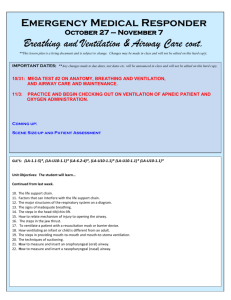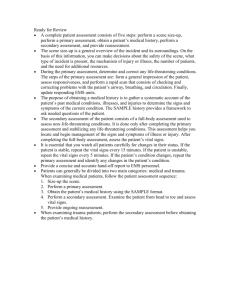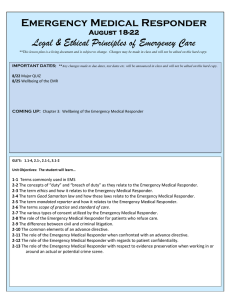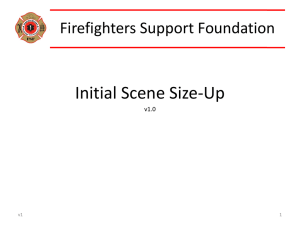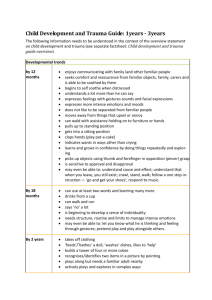11/21 Patient Assessment Trauma Soft Tissue Injuries
advertisement
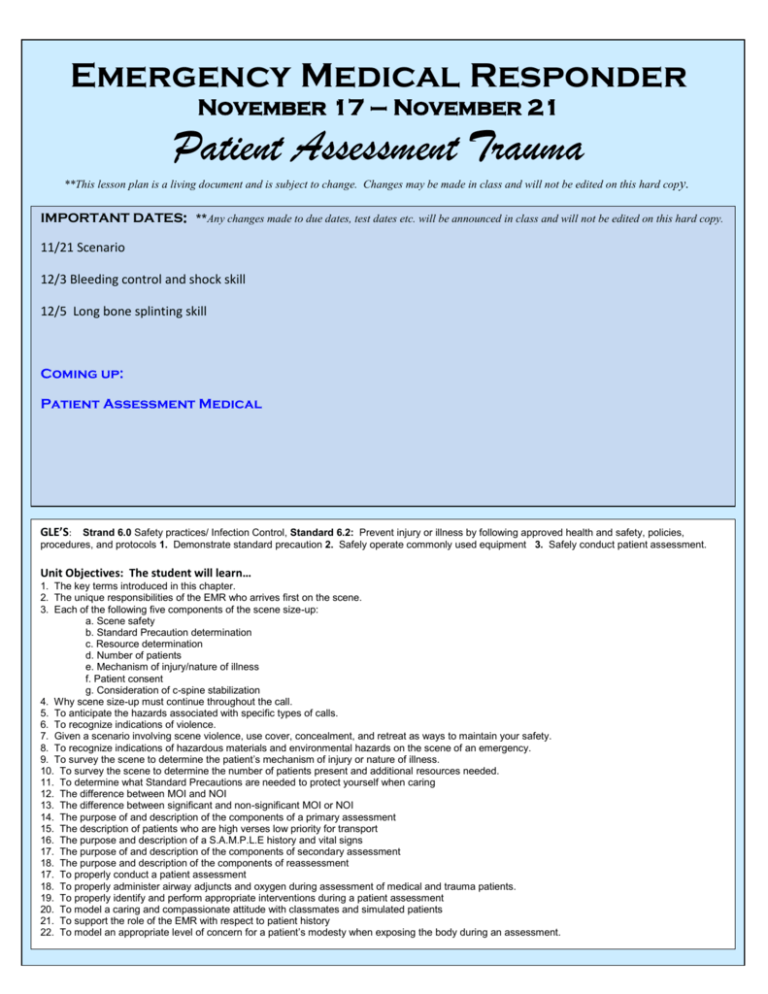
Emergency Medical Responder November 17 – November 21 Patient Assessment Trauma **This lesson plan is a living document and is subject to change. Changes may be made in class and will not be edited on this hard cop y. IMPORTANT DATES: **Any changes made to due dates, test dates etc. will be announced in class and will not be edited on this hard copy. 11/21 Scenario 12/3 Bleeding control and shock skill 12/5 Long bone splinting skill Coming up: Patient Assessment Medical GLE’S: Strand 6.0 Safety practices/ Infection Control, Standard 6.2: Prevent injury or illness by following approved health and safety, policies, procedures, and protocols 1. Demonstrate standard precaution 2. Safely operate commonly used equipment 3. Safely conduct patient assessment. Unit Objectives: The student will learn… 1. The key terms introduced in this chapter. 2. The unique responsibilities of the EMR who arrives first on the scene. 3. Each of the following five components of the scene size-up: a. Scene safety b. Standard Precaution determination c. Resource determination d. Number of patients e. Mechanism of injury/nature of illness f. Patient consent g. Consideration of c-spine stabilization 4. Why scene size-up must continue throughout the call. 5. To anticipate the hazards associated with specific types of calls. 6. To recognize indications of violence. 7. Given a scenario involving scene violence, use cover, concealment, and retreat as ways to maintain your safety. 8. To recognize indications of hazardous materials and environmental hazards on the scene of an emergency. 9. To survey the scene to determine the patient’s mechanism of injury or nature of illness. 10. To survey the scene to determine the number of patients present and additional resources needed. 11. To determine what Standard Precautions are needed to protect yourself when caring 12. The difference between MOI and NOI 13. The difference between significant and non-significant MOI or NOI 14. The purpose of and description of the components of a primary assessment 15. The description of patients who are high verses low priority for transport 16. The purpose and description of a S.A.M.P.L.E history and vital signs 17. The purpose of and description of the components of secondary assessment 18. The purpose and description of the components of reassessment 17. To properly conduct a patient assessment 18. To properly administer airway adjuncts and oxygen during assessment of medical and trauma patients. 19. To properly identify and perform appropriate interventions during a patient assessment 20. To model a caring and compassionate attitude with classmates and simulated patients 21. To support the role of the EMR with respect to patient history 22. To model an appropriate level of concern for a patient’s modesty when exposing the body during an assessment. Emergency Medical Responder November 17 – November 21 Patient Assessment Trauma **This lesson plan is a living document and is subject to change. Changes may be made in class and will not be edited on this hard cop y. MONDAY : GAME PLAN FOR THE WEEK Warm-up- Warm-up, review, & reminders Activity- Discuss methodology of patient assessment- trauma and general terminology Homework- Read over your notes TUESDAY : Warm-up- Warm-up, review, & reminders Activity- Discuss principles of Scene Size up and Primary Assessment for trauma patient Homework- Read over your notes WEDNESDAY : Warm-up- Warm-up, review, & reminders Activity- Discuss principles of History taking, Vital Signs, and Secondary Assessment of a trauma patient Homework- Read over your notes THURSDAY : Warm-up- Warm-up, review, & reminders Activity- Discuss principles of Reassessment and handoff report of a trauma patient Homework- Read over your notes FRIDAY: Warm-up- Warm-up, review, & reminders Activity- TRAUMA PATIENT SCENERIO Homework- Have a terrific holiday!!!!!!
